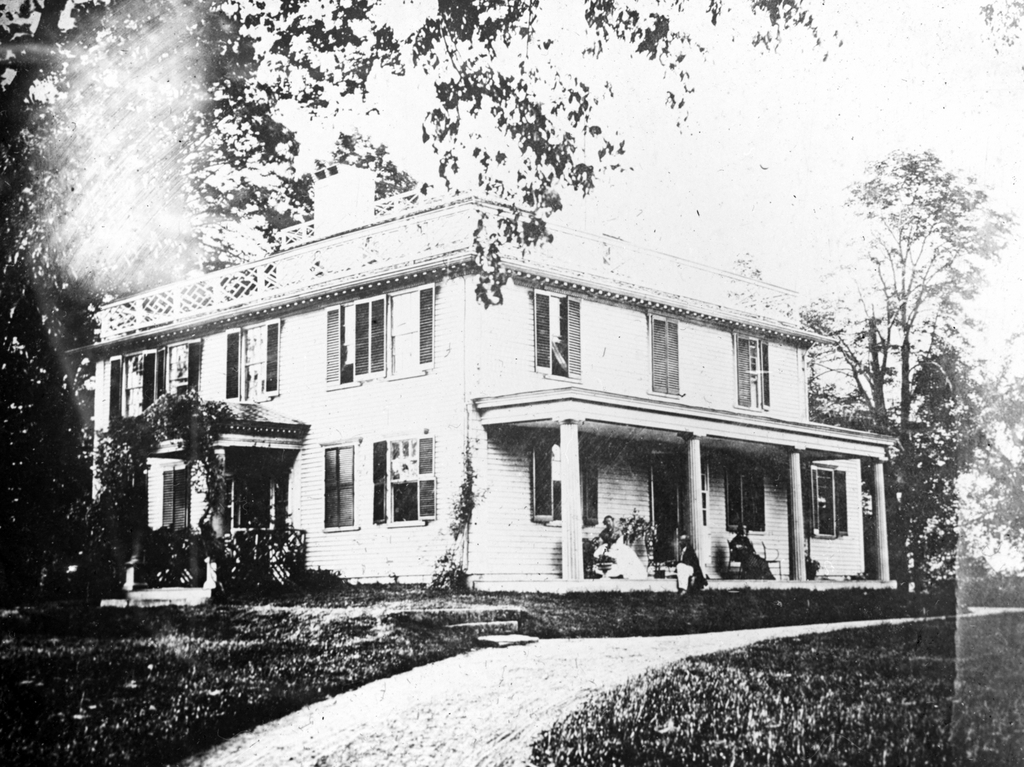The Josiah Quincy House on Muirhead Street in Quincy, around 1880. Image courtesy of the Thomas Crane Public Library.
The house in 2023:
These two photos show the former home of Josiah Quincy I, a member of the prominent Quincy family. The house is located in the Wollaston neighborhood of Quincy, and it was once part of a large estate that had been owned by family patriarch Edmund Quincy (1602-1636). His great grandson, Josiah Quincy (1710-1784), eventually inherited 100 acres of this land, and in 1770 he built this home on the property.
Josiah Quincy was a prosperous merchant, and the elaborate design of his house reflected his wealth. It is an excellent example of Georgian architecture, with distinctive exterior features such as the balustrades on the roof and the classically-inspired front portico. However, the most significant design element is the monitor roof. This is the earliest known example of such a roof in colonial America, and it is one of a relatively small number of homes that had this particular style of roof during the late 18th and early 19th centuries.
The Quincy family was prominent and well-connected politically in the years leading up to the American Revolution, and some of the family members married prominent patriot leaders. Among them was Josiah’s niece Dorothy Quincy, who married John Hancock in 1775; and Josiah’s first cousin twice removed Abigail Smith, who married John Adams. Josiah Quincy himself was also active in the patriot cause, including observing British fleet movements from the attic windows of his house. His son, Josiah Quincy Jr., was a prominent leader of the Sons of Liberty, but he died of tuberculosis in 1775, just a week after the start of the American Revolution.
If not for his untimely death, Josiah Quincy Jr. would have inherited this house. Instead, his son Josiah Quincy III (1772-1864) eventually inherited it in 1784, when the eldest Josiah died. Josiah Quincy III would go on to become probably the most famous of the many residents of this house who bore that name. He was a prominent politician, including serving in the U.S. House of Representatives from 1805 to 1813 and as mayor of Boston from 1823 to 1829. His tenure as mayor is perhaps best remembered for his role in constructing a large public market, which was named in his honor. He later went on to become president of Harvard, serving from 1829 to 1845.
Josiah Quincy III died in 1864, and he left this house to his three unmarried daughters: Eliza (1798-1884), Abigail (1803-1893), and Sophia (1805-1886). The top photo was taken around 1880, when these three sisters were still living here. Eliza Quincy played a particularly important role in preserving the house and documenting its history during her time here, and it was in part because of her efforts that the house became widely known as an architectural and historical landmark.
After the death of Abigail Quincy in 1893, her nephew Josiah Quincy V inherited the house. By this point, the home that had been a quiet country estate a century earlier was in the midst of a rapidly-developing suburb of Boston. So, in 1895 he sold off most of the surrounding land, which was then subdivided into new streets and house lots. He also sold the old house itself to Frank and Lucy Hall, who lived here until their deaths in 1913 and 1911, respectively.
In 1937, the Hall family sold the house back to the Quincy descendants, who in turn donated it to the Society for the Preservation of New England Antiquities. Now known as Historic New England, the organization continues to preserve the house as a museum, and it is open periodically for public tours. As shown in the second photo, the house has seen few changes since the first photo was taken, and it stands as an excellent example of Georgian architecture in New England. Because of its architectural and historical significance, it was added to the National Register of Historic Places in 1976 and designated as a National Historic Landmark in 1997.


